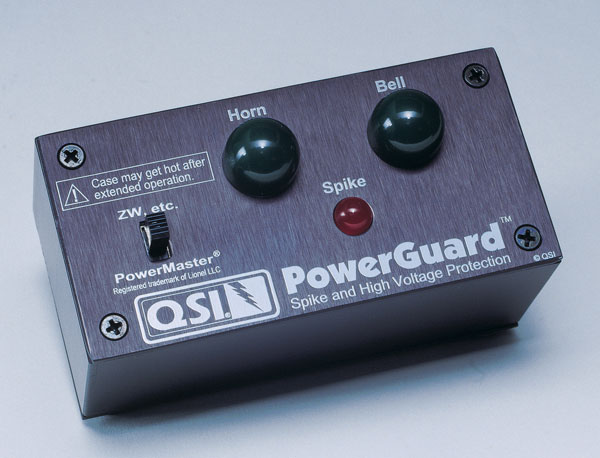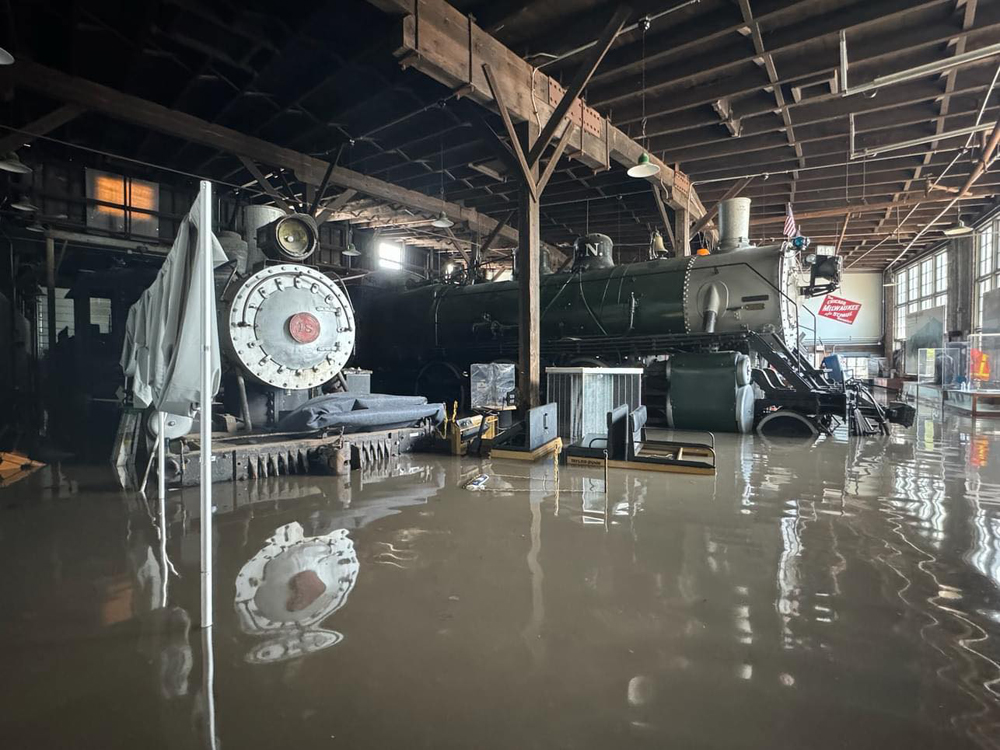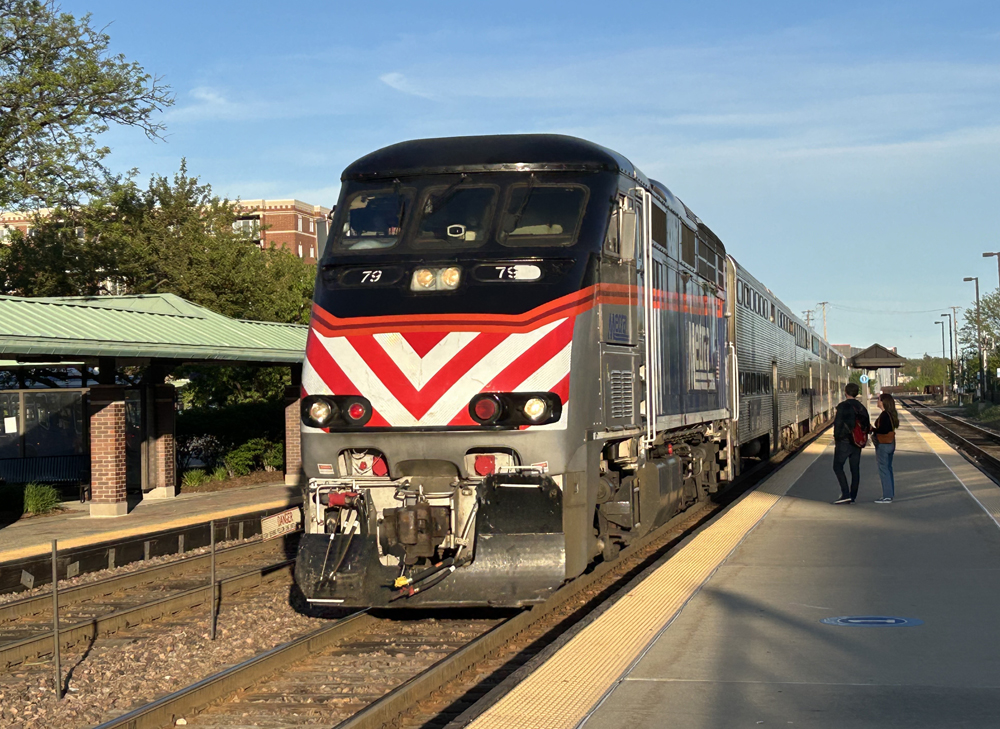QSI and spikes
In a nutshell, spikes are sudden surges in power that are produced by electrical interruptions like gaps in the track or derailments. This is why you may notice sparking as wheels roll from one track section to another. The electricity briefly surges in an attempt to force, so to speak, the current through the gap.
Normally there isn’t any danger to our three-rail equipment, but the advent of more-modern, more-powerful transformers coupled with increasingly sophisticated electronics, may be creating a problem that could take years to accurately assess.
The problem arises when spikes are beyond a level which a locomotive’s electronic components are designed to cope. The result? Bad things happen to good trains.
In 1998 QSI published a technical report on transformer spikes in which it tested the MTH Z-4000 and Z-750 transformers, the Lionel ZW, and the Lionel TrainMaster system (with Lionel ZW and Z transformer power). In the report, Fred Severson of QSI indicated the firm had observed spikes of 80 volts or more in several of the transformers. In fact, shortly before CTT finishing this review, Severson reported to us that additional testing has revealed that even the venerable ZW “had as many or more spikes” as the modern transformers, some as high as 100 volts.
That certainly got our attention, but trying to determine the scope of this problem is more difficult.
QSI electronics may be the most widely utilized after-market sound, control, and reverse systems on the market. The company has more than 500,000 QSI-designed reverse units and sound boards installed on toy trains. Between 1991 and the summer of 1997 the firm reported only five failures of the QS-1 system’s PS-1 power supply. But since 1997, the firm has reported more than 150 failures. At the very least, this suggests a trend.
As CTT noted in its review of the Weaver U25B (CTT, November 1998), it is possible, using a modern high-powered transformer (in this case a Z-4000), to fry an engine’s circuitry. This happened during a testing sequence (using the Weaver U25B) that most home operators are unlikely to duplicate: setting the throttle at 18 volts, hitting the direction button, timing a locomotive speed, hitting the direction button, and repeating the process.
When this abuse fried the circuit, CTT spoke to a Weaver representative who said the problem was that the QSI sound board in the U25B was damaged by our power supply. A QSI spokesman said the problem was the transformer. But an MTH representative said that the firm was unaware of any electronics damage caused by its power supplies. In the December 1998 issue of the MTH Railroaders Club Newsletter, MTH stated “In fact, MTH engineers have not been able to cause a QSI after-market sound system board to fail using the Z-4000.” The newsletter added that “MTH development engineers observed 100-volt spikes produced by the old ZW transformer during development testing.”
What about sound systems other than QSI? This is a tougher issue. CTT queried various component manufacturers who, overall, reported little or no known damage to their products from transformer spikes.
A Lionel representative was unaware of any RailSounds or electronic reverse units damaged by spikes from modern transformers. MTH reports no known failures of its ProtoSound system (which is designed by, but not manufactured, by QSI) due to spiking.
K-Line reported that it had not experienced any damage to engine electronics due to modern, more powerful transformers, but added that its electronics are generally straightforward.
3rd Rail reported the failure rate of QSI boards for its locomotives was slight, and the causes were generally undetermined, though 3rd Rail did cite anecdotal information from a customer regarding reported damage of several QSI units by a modern transformer.
Likewise, neither Ott Machine Services or Dallee Electronics reported failures tied to spikes, and both firms said that their circuits were designed to compensate for such power surges.
The spike problem is one that bears watching, but only time will tell.
Why? Most toy train operators don’t put a large number of hours on all of the locomotives in their fleet. A typical operating session might last for an hour or two and might find several different locomotives run during that period. It could take a given locomotive years before it accumulates even 10 or 12 hours of continuous run time, so it might be possible that low levels of noncritical damage could be inflicted on a fleet that might take years to discover.
Regardless, QSI has developed its PowerGuard to act as a last line of defense between your locomotives and potential damage from spiking.
What is the PowerGuard?
First, the PowerGuard is basically a surge protector for shielding your locomotive electronics from spikes.
It is a small box that easily hooks up to the negative and positive posts of your transformer. It is added to the posts, not placed “in-line” between the posts and the track.
It has a red light that illuminates when power is first applied and each subsequent time that it detects and suppresses a power spike. It also has two green lights, one marked “horn” and the other “bell,” for measuring power (bright is high, dim is low). A switch allows you to select between conventional transformers like the ZW or the TrainMaster system.
A secondary benefit of PowerGuard is that when connected to Lionel’s TrainMaster system using a power source such as a ZW, it helps smooth out the power’s signal and eliminates any odd horns, bleeps, or other spontaneous noises when using gear equipped with QS-2+ circuit boards.
Testing
How would you go about testing this product?
In the past year, CTT has tested more than 32 AC-powered locomotives with three modern power sources, the Lionel TrainMaster, the MTH Z-4000 and the MRC Dual Power O-27, and encountered a spike problem with only one engine. We decided that the most obvious method to test the PowerGuard would be to try to fry a locomotive.
Well, nobody was rushing to the front of the line with their favorite engine for testing, so we opted for a lower-octane approach, which was to hook the PowerGuard to our high-powered Z-4000 and an MRC DualPower O-27 transformer, and run a variety engines through a regimen duplicating our high-speed 18 volt testing.
We did this with engines that were in the batter’s box for product reviews as well as engines brought in from staff collections. Each engine was tested with and without the Power Guard.
During that time we ran more than 22 locomotives through the ritual. These were made by Atlas O, K-Line, Lionel, MTH, Marx, 3rd Rail, Weaver, and Williams. We had engines with a variety of sound systems and others without. We tested silent or horn-only as well. Our results? No fried circuitry.
While we don’t know for certain whether any of the spikes generated during testing would have critically damaged our locomotive circuitry, we do know that all survived the testing with PowerGuard installed.
Electronic component manufacturers need to ensure that the sound, power, and other control boards they make are robust enough to win the war with power spikes. In the meantime, spike surge protectors such as the PowerGuard may be needed to fill the gap.
If you are running “the big boys” of the modern transformer crowd, PowerGuard seems to be a reasonable investment in home layout defense.














